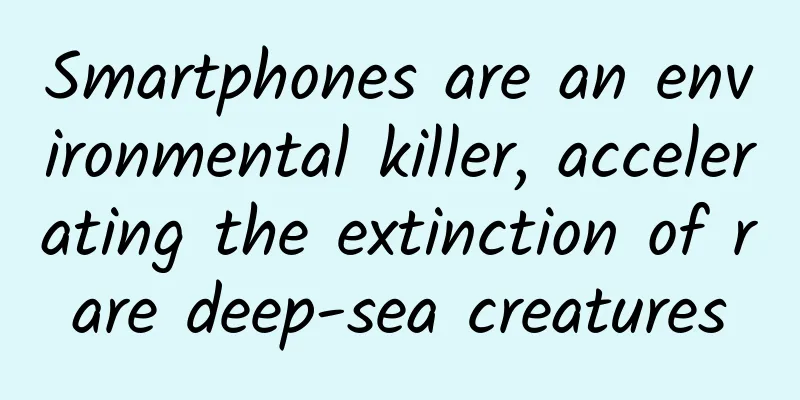Smartphones are an environmental killer, accelerating the extinction of rare deep-sea creatures

|
According to foreign media reports, last March, when the National Oceanic and Atmospheric Administration was exploring the deep seabed of Hawaii, they made an amazing discovery. Under the illumination of the remote-controlled submersible's detection light, a lavender unknown octopus species appeared in front of them. This gel-like little octopus stared at the camera cutely, instantly becoming popular on the Internet and earning it a cute nickname: Casper (a character in the movie "Casper"). Unfortunately, the deep-sea environment where these adorable octopods live is under serious threat in the near future. The seafloor plains where Casper and many other deep-sea species live are littered with nodules of various metals, including manganese, nickel, zinc, copper, gold, and more. These are metals that humans are in great demand for, in part because they can be used in electronic devices such as smartphones. Mining companies have coveted these areas for decades, but have been unable to access them - until now. With the advent of cost-effective deep-sea mining technology, species such as Casper's octopus, which were previously unmolested by human activities, are in danger. Polymetallic nodules are potato-sized pieces of metal that form much like pearls in oysters: metal fragments slowly combine with tiny objects over time. Although the time required for their formation is still debated, Otto Pazer, an ecologist at the Helmholtz Center for Polar and Marine Research in Germany, said that in the time of Napoleon or Caesar, these objects were probably only about half a millimeter thick, so they formed very slowly. "They are always distributed in deep waters in all major oceans of the world, with different distribution densities," Pazer said. However, he also said that the density of these objects is higher in deep-sea basins between 3,000 and 6,000 meters in the Pacific and Indian Oceans. The Clarion-Clipperton Zone in the Pacific contains about 21 billion tons of manganese nodules, covering an area the size of Europe. The metal nodules are scattered in the sand, but because there is no other hard substrate where they are located, they act as reefs. Sponges and other attached organisms can anchor themselves to these metal rocks, which in turn provide habitats for various deep-sea creatures. Deep-sea polymetallic nodules Some large mobile organisms, such as sea cucumbers, deep-sea shrimps, deep-sea fish, sea brittle stars, and the cute casper octopus, live in these metal nodule areas, foraging and reproducing here. Under the muddy seabed, there are also many creeping creatures that live and die in the mud. " There are many creatures in this mud," said Pazer. Crabs, shellfish and copepods make their homes in the sediments, and casper octopuses can use their tentacles to forage in the mud. However, these mysterious deep-sea animal homes are about to be invaded by large machines. Currently, the International Seabed Authority has designated an area of about 1.4 million square kilometers at depths between 800 and 6,000 meters for mining companies to explore. "Mining will start soon, possibly as early as next year," said Patzer. Octopus Casper By then, not only will starfish and other animals that live directly on the metal nodules die, but mobile creatures such as the casper octopus will also be negatively affected. If the metal nodules are removed, the sponges that rely on them for spawning will also disappear. In addition, the disappearance of top predators such as octopuses will trigger a chain reaction that will break the balance of the seabed ecosystem. Mining companies are likely to use a huge machine similar to a potato harvester. These 300-ton robotic tractors will "plow" the seabed, rolling sediments and shoveling up manganese stones. This will cause a "mud cloud" to rise on the seabed, which will have a devastating effect on the animals living in it. These machines may even exacerbate climate change because it will destroy the ocean's natural carbon storage process. "These are often very old, very slow-growing ecosystems," said Douglas McCauley, a marine biologist at the University of California, Santa Barbara. "The species found there are nowhere else on Earth, and many are just being discovered." Because so little is known about these mysterious ecosystems, it is difficult to get protective legislation before mining begins. Patzer said the International Seabed Authority must take the initiative to come up with protection plans, and hopefully it won't be too late.As a winner of Toutiao's Qingyun Plan and Baijiahao's Bai+ Plan, the 2019 Baidu Digital Author of the Year, the Baijiahao's Most Popular Author in the Technology Field, the 2019 Sogou Technology and Culture Author, and the 2021 Baijiahao Quarterly Influential Creator, he has won many awards, including the 2013 Sohu Best Industry Media Person, the 2015 China New Media Entrepreneurship Competition Beijing Third Place, the 2015 Guangmang Experience Award, the 2015 China New Media Entrepreneurship Competition Finals Third Place, and the 2018 Baidu Dynamic Annual Powerful Celebrity. |
>>: Ten old iPhones were put into water for three minutes and all died
Recommend
Everything you want is here: 138 operation tools recommended! (Recommended for collection)
About the platform, about pictures, about typeset...
Domestic mobile phone "Three Kingdoms Killing": Xiaomi, Huawei and Meizu "Double 11" secret battle
Domestic mobile phones achieved amazing sales on ...
Observation on Brazil's new energy vehicle industry: small scale but fast growth, Chinese manufacturers have an absolute advantage
In the past few years, the global new energy vehi...
How does Baodao Glasses manage user operations?
The company I’m going to dissect for you today is...
Start a course_C language programming 4
Start a course_Introduction to C language program...
Building high-performance enterprise product architecture with Laravel
Using Laravel to build high-performance enterpris...
How to create opium-like articles that users can’t stop reading? (Down)
Fear, excitement, novelty and confusion - what ki...
Hitting the profit pain point, video websites are brewing a paid model
Can video websites, which have always had profit ...
Official account: Market Talk + Sector Trends Small Circle June Edition Video
Public account: Market Talk + Sector Trends Small...
Upgrade! Apple iOS 15.2 is officially released: fixes a lot of bugs and adds many new features
[[440213]] Apple today released iOS 15.2 and iPad...
On the third anniversary of the landing on Mars, let's review the thrilling 9 minutes of Tianwen-1's landing on Mars
At 7:18 a.m. on May 15, 2021, China's Tianwen...
The demon boy moves to the deep sea! 30 minutes of power = 21 times the Asian sandstorm?
Nezha 2 has swept the world at the box office, an...
Heavy rain hit Mianning, Sichuan at night and killed a family of five. 2020 is truly an extraordinary year!
On the evening of June 26, heavy rain and torrent...
Just like the leak, let me show you the Apple conference in 3 minutes
This morning, Apple officially released the iPhon...
Is it reliable to take Western medicine while drinking Chinese medicine?
This is the 4648th article of Da Yi Xiao Hu When ...









